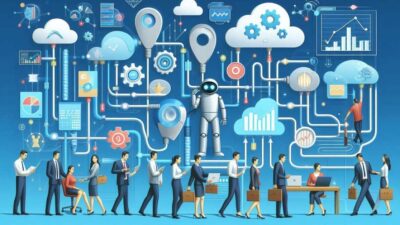
In today’s volatile business landscape, the ability to accurately predict future revenue isn’t just a competitive advantage—it’s becoming a fundamental requirement for survival. AI sales forecasting has emerged as the game-changing technology that’s transforming how businesses anticipate their financial future, moving beyond the limitations of traditional methods that rely heavily on intuition and historical averages. By leveraging sophisticated predictive sales analytics, organizations are achieving unprecedented forecast accuracy while simultaneously reducing the time investment required from sales teams. For executives tired of constantly missing projections and sales leaders frustrated by subjective forecasting processes, AI revenue prediction offers a compelling solution—one that promises not just incremental improvements in accuracy but a fundamental shift toward objective, data-driven decision-making that can reshape strategic planning, resource allocation, and ultimately, business performance.
The Evolution of Sales Forecasting
Traditional Forecasting Methods and Their Limitations
Before diving into how AI is revolutionizing sales forecasting, it’s important to understand the conventional approaches and their inherent challenges:
Common Traditional Forecasting Methods
- Historical Averaging: Projecting future sales based on past performance, often with basic growth assumptions
- Sales Rep Judgment: Collecting subjective assessments from sales representatives about deal likelihood
- Pipeline Stage Forecasting: Assigning standard probabilities based on sales pipeline stages
- Moving Averages: Using weighted averages of past periods to project future performance
- Linear Regression: Basic statistical approaches to identify trends in historical data
These approaches have persisted for decades despite significant limitations:
| Limitation | Business Impact |
| Subjective assessments | Inconsistent evaluations leading to skewed projections |
| Limited data incorporation | Overlooking crucial signals and indicators |
| Static probability assumptions | Failure to adapt to changing market conditions |
| Excessive manual input | Time-consuming processes diverting sales team focus |
| Delayed insights | Outdated projections by the time forecasts are compiled |
The limitations of traditional methods create ripple effects throughout organizations, affecting everything from inventory management to hiring decisions and investor relationships.
The Transition to Data-Driven Forecasting
The shift toward more sophisticated forecasting approaches has occurred in distinct phases:
- CRM Integration Phase: Centralizing sales data and standardizing pipeline stages
- Analytics Phase: Applying basic statistical analysis to pipeline data
- Early Automation Phase: Creating rules-based systems for probability assignments
- Machine Learning Introduction: Developing initial predictive models with limited data sets
- Current AI-Driven Phase: Implementing comprehensive machine learning systems with multi-source data integration
This evolution reflects both technological advancement and organizational maturity in data management. Today’s most sophisticated forecasting systems leverage artificial intelligence to process vast quantities of structured and unstructured data while continuously improving their predictive capabilities.
How AI Is Transforming Sales Forecasting
Core AI Technologies Powering Modern Forecasting
AI sales forecasting relies on several foundational technologies working in concert:
Machine Learning Models
The heart of AI-driven forecasting lies in sophisticated machine learning sales forecasting algorithms that:
- Identify complex patterns in historical sales data
- Recognize correlations between diverse factors and sales outcomes
- Adapt continuously based on new information and results
- Generate increasingly accurate predictions as data volume grows
These models go far beyond basic statistical approaches by detecting subtle relationships that would be impossible for human analysts to discern.
Natural Language Processing (NLP)
NLP capabilities enable forecasting systems to incorporate qualitative data by:
- Analyzing sales call transcripts for sentiment and buying signals
- Extracting insights from email exchanges between sales reps and prospects
- Monitoring customer support interactions for expansion opportunities
- Reviewing meeting notes for nuanced information about deal progress
This technology transforms previously untapped unstructured data into valuable forecasting inputs.
Time Series Analysis
Specialized algorithms designed for temporal data help forecasting systems:
- Identify seasonal patterns and cyclical trends
- Detect anomalies that may signal market shifts
- Account for varying sales cycles across products and segments
- Project future performance with appropriate confidence intervals
These capabilities ensure that forecasts properly reflect time-dependent factors that influence sales outcomes.
Ensemble Methods
Advanced AI systems often employ multiple models simultaneously to:
- Compare predictions from different algorithmic approaches
- Weight various models based on historical accuracy
- Create composite forecasts that incorporate diverse perspectives
- Maximize prediction stability and reliability
This approach helps mitigate the weaknesses of any single model while leveraging collective insights.
Key Advantages of AI-Powered Forecasting
The transition to AI-driven approaches delivers several transformative benefits:
Accuracy Improvements
Perhaps the most compelling advantage is significantly enhanced forecast accuracy:
- Reduction in forecast variance from ±30% to ±10% or better
- Elimination of consistent over-forecasting or under-forecasting biases
- Improved accuracy across different time horizons (weekly, monthly, quarterly)
- Enhanced precision at multiple organizational levels (individual, team, regional, global)
These improvements directly impact business planning, cash flow management, and shareholder confidence.
Objective Probability Assessment
AI removes much of the subjectivity inherent in traditional forecasting:
- Consistent evaluation criteria applied across all opportunities
- Evidence-based probability assignments
- Reduction in optimism bias and sandbagging
- Decreased influence of individual sales rep forecasting styles
This objectivity creates a more reliable foundation for organizational decision-making.
Comprehensive Data Utilization
AI systems can incorporate vastly more data points than traditional methods:
- Internal data from CRM, ERP, and marketing automation systems
- External factors including market trends and competitive activities
- Historical patterns across thousands of previous opportunities
- Indirect signals such as prospect engagement metrics and communication patterns
This comprehensive approach ensures that forecasts reflect the complete picture rather than limited perspectives.
Dynamic Adaptation
Unlike static forecasting methods, AI systems continuously evolve:
- Real-time forecast updates as new information emerges
- Automatic adjustment to changing market conditions
- Self-correction based on previous prediction accuracy
- Ongoing refinement of predictive models
This adaptability ensures that forecasts remain relevant even in rapidly changing business environments.
Key Components of Effective AI Sales Forecasting Systems
Data Integration and Preparation
The foundation of effective AI forecasting lies in comprehensive data integration:
Essential Data Sources
Robust forecasting systems typically incorporate data from:
- CRM platforms (opportunity details, activities, pipeline stages)
- Marketing automation systems (lead sources, campaign effectiveness)
- ERP and financial systems (historical transaction data, customer purchasing patterns)
- Customer success platforms (product usage, satisfaction metrics)
- Communication systems (email, call, and meeting records)
This integration provides the diverse inputs required for sophisticated analysis.
Data Quality and Standardization
For AI to generate reliable predictions, organizations must address:
- Data completeness across critical fields
- Standardization of definitions and categorizations
- Historical data accuracy and consistency
- Appropriate handling of exceptional cases and outliers
These foundational elements ensure that AI algorithms have quality inputs from which to derive insights.
At Salesix.ai, we’ve seen how proper data preparation can dramatically improve forecast accuracy, with organizations achieving up to 40% greater precision simply by enhancing data quality before implementing AI forecasting.
Predictive Modeling Approaches
Different forecasting needs require different modeling approaches:
Opportunity-Level Prediction
For detailed pipeline analysis, AI systems employ models that:
- Assess individual opportunities based on hundreds of variables
- Generate specific probability scores for each potential deal
- Predict likely close dates and deal values
- Identify factors influencing particular opportunity outcomes
These granular predictions provide sales representatives with actionable insights for specific opportunities.
Aggregate Forecasting
For organizational planning, AI systems create broader projections that:
- Forecast total revenue across regions, products, and time periods
- Incorporate macro-economic and industry-specific factors
- Account for new business, expansion, and churn components
- Generate confidence intervals to inform risk assessment
These aggregate models support executive decision-making and strategic planning.
Deal Characteristic Analysis
To improve sales strategy, sophisticated systems identify:
- Attributes that correlate with higher close rates
- Factors associated with larger deal sizes
- Signals that indicate faster sales cycles
- Patterns related to higher customer lifetime value
These insights help organizations optimize their approach beyond simple revenue prediction.
User Experience and Visualization
Even the most sophisticated forecasting models deliver value only when properly communicated:
Intuitive Dashboards
Effective systems provide:
- Visual representations of current forecasts and trends
- Drill-down capabilities from aggregate to detailed views
- Comparison views (forecast vs. actual, current vs. previous)
- Confidence indicators and variance metrics
These visualizations translate complex predictions into actionable intelligence.
Scenario Analysis Tools
Advanced platforms enable users to:
- Model different assumptions and business conditions
- Visualize best-case, worst-case, and expected scenarios
- Assess the impact of potential strategy changes
- Evaluate resource allocation alternatives
These tools transform forecasting from passive prediction to active planning support.
Implementing AI Sales Forecasting: Strategic Approaches
Organizational Readiness Assessment
Before implementing AI forecasting, organizations should evaluate:
- Data maturity: Availability and quality of essential sales and customer data
- Process standardization: Consistency of sales stages and terminology
- Cultural factors: Team openness to data-driven decision-making
- Technical infrastructure: Systems capability to support AI implementation
- Executive alignment: Leadership understanding and support for the transition
This assessment helps identify prerequisites and potential obstacles before significant investment.
Implementation Phases
Successful organizations typically adopt phased approaches:
Initial Pilot
Starting with limited scope allows organizations to:
- Test AI forecasting in a controlled environment
- Demonstrate value before broader deployment
- Identify implementation challenges
- Build internal expertise
Common pilot approaches include focusing on specific product lines, regions, or sales teams.
Parallel Operation
Running new and existing forecasting methods simultaneously enables:
- Direct comparison of accuracy and insights
- Gradual confidence building
- Identification of edge cases requiring attention
- Refinement of AI models with minimal disruption
This phase typically lasts 3-6 months, gradually shifting reliance toward the AI system.
Full Integration
Complete implementation involves:
- Integration with planning and budgeting processes
- Incorporation into performance management systems
- Alignment with inventory and resource planning
- Embedding in executive reporting and investor communications
This final phase transforms AI forecasting from a sales tool to a core business system.
Change Management Considerations
The transition to AI-driven forecasting requires thoughtful change management:
Sales Team Engagement
Sales representatives may initially resist automated forecasting due to:
- Concerns about judgment replacement
- Skepticism about algorithm accuracy
- Fear of increased scrutiny
- Uncertainty about new requirements
Addressing these concerns through transparent communication, involvement in design, and clear articulation of benefits is essential for adoption.
Leadership Alignment
Executive support hinges on:
- Understanding AI capabilities and limitations
- Setting realistic accuracy expectations
- Recognizing implementation timeframes
- Commitment to data-driven decision-making
This alignment ensures consistent organizational direction throughout the transition process.
Real-World Applications and Industry-Specific Approaches
Sector-Specific AI Forecasting Implementation
Different industries face unique forecasting challenges requiring tailored approaches:
Pharmaceutical Sales
In pharmaceutical sales, AI forecasting systems typically incorporate:
- Prescription data and trends
- Healthcare provider specialties and patient demographics
- Formulary status and reimbursement factors
- Regulatory approval timelines
- Competitive product launch information
These specialized inputs enable more accurate forecasting in this highly regulated environment.
Financial Services
Banks and financial institutions leverage AI for forecasting that considers:
- Economic indicators and interest rate projections
- Customer financial health metrics
- Regulatory changes and compliance requirements
- Seasonal patterns in different financial products
- Customer life events and wealth milestones
These factors enable more nuanced projections for complex financial portfolios.
E-commerce
Online retailers employ AI forecasting that analyzes:
- Website traffic patterns and conversion trends
- Basket analysis and cross-selling opportunities
- Seasonal buying cycles and promotional response rates
- Inventory levels and product availability
- Competitive pricing dynamics
This comprehensive approach helps manage the volatility inherent in digital commerce.
Technology Services
B2B technology companies implement AI systems that evaluate:
- Technology adoption curves and innovation cycles
- Contract renewal probabilities
- Usage-based expansion opportunities
- Customer health scores and engagement metrics
- Competitive displacement potential
These specialized indicators provide more accurate projections in subscription-based business models.
Voice AI Integration for Enhanced Data Collection
Advanced forecasting systems are increasingly incorporating voice AI to:
- Automatically capture insights from sales calls
- Extract commitment language and next steps
- Identify objections and areas of concern
- Assess prospect engagement and sentiment
At Salesix.ai, our voice agents not only facilitate sales conversations but capture valuable intelligence that feeds directly into forecasting models, creating a continuous improvement loop that enhances prediction accuracy over time.
Measuring Success: Forecast Accuracy Metrics
Key Performance Indicators
Evaluating AI forecasting effectiveness requires tracking meaningful metrics:
Accuracy Measurements
Core precision metrics include:
- Mean Absolute Percentage Error (MAPE): Average percentage difference between forecasted and actual values
- Forecast Bias: Tendency to consistently over-forecast or under-forecast
- Forecast Stability: Consistency of predictions over time
- Win Rate Accuracy: Correlation between predicted probabilities and actual outcomes
These measurements help quantify improvement over traditional methods.
Process Efficiency Metrics
Beyond accuracy, organizations should monitor:
- Time spent on forecast preparation
- Forecast frequency and freshness
- Exception handling requirements
- Manual adjustment frequency
These indicators help quantify the operational benefits of automated forecasting.
Business Impact Indicators
Ultimately, successful forecasting should improve:
- Inventory management efficiency
- Resource allocation effectiveness
- Cash flow predictability
- Strategic planning confidence
These broader business impacts justify investment in advanced forecasting capabilities.
Comparative Analysis: Before and After Implementation
Organizations can assess AI’s value through before-and-after comparison:
| Metric | Typical Pre-AI Performance | Potential Post-AI Results |
| Forecast accuracy (MAPE) | 25-35% | 10-15% |
| Forecasting time investment | 8-12 hours per week per sales manager | 2-3 hours per week per sales manager |
| Forecast update frequency | Monthly or quarterly | Weekly or real-time |
| Granularity | Product line or region | Individual opportunity |
| Insight generation | Limited manual analysis | Automated actionable recommendations |
Overcoming Common Challenges in AI Forecasting Implementation
Data Quality and Availability Issues
The effectiveness of AI forecasting depends heavily on data quality. Common challenges include:
- Incomplete CRM data: Missing fields and inconsistent entry
- Limited historical records: Insufficient examples for robust pattern recognition
- Data silos: Critical information trapped in disconnected systems
- Inconsistent definitions: Varying interpretations of sales stages and terminology
Organizations can address these challenges through:
- Implementing data governance policies
- Creating data quality incentives
- Investing in integration technologies
- Standardizing sales process terminology
These investments create the foundation for effective AI forecasting.
Balancing Automation and Human Judgment
Finding the optimal balance between algorithmic prediction and human insight presents challenges:
- Override protocols: Determining when manual adjustments are appropriate
- Explainability needs: Making AI decisions understandable to stakeholders
- Edge case handling: Managing unusual situations that fall outside model parameters
- Confidence calibration: Aligning prediction confidence with appropriate action
Successful organizations develop clear guidelines for human-machine collaboration that leverage the strengths of both.
Integration with Existing Business Processes
For maximum impact, AI forecasting must connect with broader business systems:
- Planning and budgeting alignment: Synchronizing forecasting and financial planning cycles
- Performance management integration: Connecting predictions to incentive systems
- Resource allocation processes: Using forecasts to drive staffing and investment decisions
- Executive reporting frameworks: Incorporating AI insights into leadership communications
These integrations transform forecasting from an isolated function to a core business driver.
The Future of AI in Sales Forecasting
Emerging Trends and Technologies
The AI sales forecasting landscape continues to evolve rapidly. Key trends include:
Prescriptive Forecasting
Next-generation systems are moving beyond prediction to prescription by:
- Recommending specific actions to improve outcomes
- Suggesting optimal resource allocation based on forecasted scenarios
- Identifying intervention opportunities for at-risk opportunities
- Automating routine responses to common forecasting insights
This evolution transforms forecasting from passive reporting to active business guidance.
External Data Integration
Advanced forecasting systems increasingly incorporate external factors such as:
- Macroeconomic indicators and industry-specific metrics
- Social media sentiment and brand perception data
- Competitive activity and market share shifts
- Weather patterns and environmental factors (for relevant industries)
This broader context improves accuracy by capturing forces beyond internal sales activities.
Automated Scenario Planning
Emerging systems enable:
- Continuous simulation of multiple future scenarios
- Automatic recalibration based on early signals
- Risk assessment across different potential outcomes
- Strategy recommendations optimized for forecast uncertainty
These capabilities help organizations prepare for multiple futures rather than betting on a single prediction.
Preparing Your Organization for Advanced Forecasting
Forward-thinking companies are already preparing for next-generation capabilities by:
- Building flexible data architectures that can incorporate diverse input sources
- Developing skills in data science and machine learning interpretation
- Creating cultures comfortable with algorithmic decision support
- Implementing agile planning processes that can respond to dynamic forecasts
These preparations position organizations to capitalize on emerging technologies rather than struggling to catch up with competitors.
Conclusion
AI sales forecasting represents not just an incremental improvement but a fundamental transformation in how businesses anticipate future revenue. By leveraging machine learning, natural language processing, and advanced analytics, organizations can move beyond the limitations of traditional forecasting methods to achieve unprecedented accuracy while simultaneously reducing the manual burden on sales teams. The benefits extend far beyond the sales organization—touching everything from inventory management and resource planning to investor relations and strategic decision-making.




